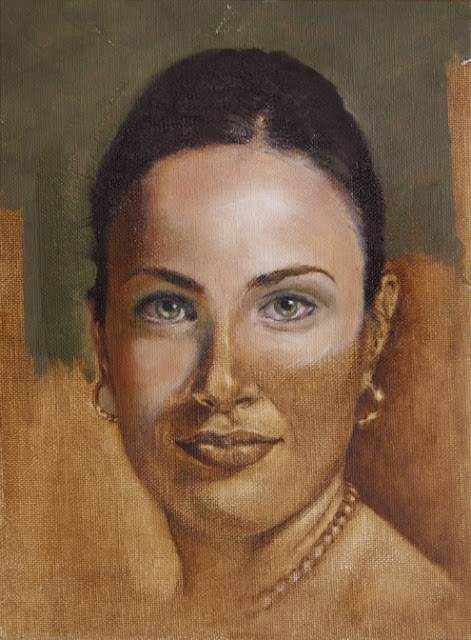Part 1, which dealt with griding, drawing and the rub out under painting stage.
Part 2, which included premixing a flesh tone palette and storage of paint;
Part 3, in which I explored oiling out, and the pros and cons of working from photographs;
Part 4, a session of discoveries and surprises.
Part 5, noticing color shifts and tips for accurate drawing.
I worked on this with the class, on the upper lip, lips and neck. I knew it wasn't going great. I was having trouble with the chin and the shadow under the chin. I demoed for about an hour, then turned them loose on their own work. It's amazing how tricky it is trying to explain what I'm doing, answer questions, paint, see, all while trying to stand to the side so they can see.
A few days later back in the studio I could see that I had shortened the model's chin.
So I used one of my favorite tricks, flipped it upside down and got medieval on it. About 2 hours later I considered it passable.
But alas this is just a study, and it's time to move on. This was the first head study that I've ever done from start to finish with a class and it has been a huge learning experience for me.
I'm so proud of the work they have done. For some of them this is the first face they've ever painted, some had never picked up a brush until a few months ago, some have only been painting abstracts or impressionistic work until taking my class in the past few months.
We have all been "lingering in the uncomfortable zone" where real learning takes place and it's been a blast! With their permission I'm sharing a few of them here. Their work is in varying stages of finish.
 |
| Dru Griffith |
 |
| Ira Turner |
 |
| Janie Chambers |
 |
| Laura Nigg |
 |
| Paul Brooks |
 |
| Suzette Shell |
 |
| Jamie Wilson |
If they master these principles, they may choose to discard them later to embrace another style. If they do so it will be because they choose to and not because they are limited in their knowledge and skill.
My philosophy is that these are tools for the tool box and the more you have the easier it is to create the vision in your head.





I don't know how I missed this post but I am so happy I stumbled upon it looking for another of your demos :)
ReplyDeleteWhat great results everyone had. It is really very cool to see all the different styles from the same method and reference coming out so differently.
Thanks again for posting these, so helpful...makes me want to run back up to my studio :)
Thanks Tracey, I am very proud of my students. So glad you are enjoying the blog.
ReplyDeleteI came upon this site through a friends facebook page. And enjoyed it so much. Thank you for sharing I've learned so much. It help so much to see how other people work. Working out the thing on my own, I got most things right mostly on instinct not method so these classes explained the method to me. I will follow your blogs in future.
ReplyDeleteSouth Africa
Hello in South Africa. I'm glad you are enjoying the blog! Thank you for being a reader. Happy Painting!
DeleteTerry this is so great! I love reading and seeing your process, and your students work is all so fantastic!
ReplyDelete